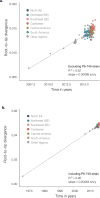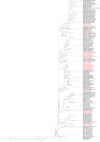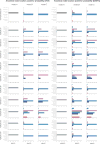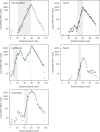Establishment and cryptic transmission of Zika virus in Brazil and the Americas
- PMID: 28538727
- PMCID: PMC5722632
- DOI: 10.1038/nature22401
Establishment and cryptic transmission of Zika virus in Brazil and the Americas
Abstract
Transmission of Zika virus (ZIKV) in the Americas was first confirmed in May 2015 in northeast Brazil. Brazil has had the highest number of reported ZIKV cases worldwide (more than 200,000 by 24 December 2016) and the most cases associated with microcephaly and other birth defects (2,366 confirmed by 31 December 2016). Since the initial detection of ZIKV in Brazil, more than 45 countries in the Americas have reported local ZIKV transmission, with 24 of these reporting severe ZIKV-associated disease. However, the origin and epidemic history of ZIKV in Brazil and the Americas remain poorly understood, despite the value of this information for interpreting observed trends in reported microcephaly. Here we address this issue by generating 54 complete or partial ZIKV genomes, mostly from Brazil, and reporting data generated by a mobile genomics laboratory that travelled across northeast Brazil in 2016. One sequence represents the earliest confirmed ZIKV infection in Brazil. Analyses of viral genomes with ecological and epidemiological data yield an estimate that ZIKV was present in northeast Brazil by February 2014 and is likely to have disseminated from there, nationally and internationally, before the first detection of ZIKV in the Americas. Estimated dates for the international spread of ZIKV from Brazil indicate the duration of pre-detection cryptic transmission in recipient regions. The role of northeast Brazil in the establishment of ZIKV in the Americas is further supported by geographic analysis of ZIKV transmission potential and by estimates of the basic reproduction number of the virus.
Figures











Comment in
-
Epidemiology: Molecular mapping of Zika spread.Nature. 2017 Jun 15;546(7658):355-357. doi: 10.1038/nature22495. Epub 2017 May 24. Nature. 2017. PMID: 28538722 No abstract available.
-
Brazil's researchers overturn government ruling.Nature. 2020 Mar;579(7799):343. doi: 10.1038/d41586-020-00783-1. Nature. 2020. PMID: 32184485 No abstract available.
References
-
- Ministério da Saúde. Boletins Epidemiológicos—Secretaria de Vigilância em Saúde. 2017 http://portalsaude.saude.gov.br/index.php/o-ministerio/principal/secreta....
-
- WHO. Situation Report - Zika virus, microcephaly, Guillain-Brarré syndrome. 2017 Jan 18; ( http://apps.who.int/iris/bitstream/10665/253604/1/zikasitrep20Jan17-eng...., 2017)
Publication types
MeSH terms
Grants and funding
LinkOut - more resources
Full Text Sources
Other Literature Sources
Medical

